This article is about different coffee brewing techniques that don’t require plug-in machines. Many people swear by expensive espresso makers, pod machines, or electric percolators, but I prefer the simplicity of manual devices. These are quiet, dependable, portable, and cheap.
We will take a look at five brewing techniques involving minimal equipment, but which will give you amazing coffee if done right.
The rise of espresso
Before we get started, a word on espresso. Since the late 1990s we have witnessed the remarkable rise of coffee-shop culture. This has centred on US chain shops brewing espresso-based milky coffees. A relatively niche Italian coffee recipe was combined with a fast-food model, and this is now the dominant form of away-from-home coffee consumption. Espresso is a wonderful coffee, but it’s hard to get right without the expensive equipment needed for the high extraction pressure. And all that frothy milk that most people want to dilute it with is really not that good for you. So, whilst the rest of the world continues to obsess with espresso-based lattes and flat whites, let’s focus on some other options.
Grinding your beans
The best way to make coffee is to grind your beans yourself. Buying pre-ground coffee is less fresh and is going to restrict your ability to match the fineness of the grind to the particular brewing method. When picking a grinder you want one with burrs which grind, rather than blades which harshly chop up the bean. In keeping with the manual (and quiet) approach I like to use a hand grinder. These have really improved in recent years and the key factor to go for is grinding speed. I have a Timemore Slim Plus which costs £80. It is a sleek bit of kit, takes up little space, and grinds very fast without waking everyone up. It can grind up to 25g in a batch and at medium coarseness this takes about 30 seconds. You can easily adjust the burrs setting to change the coarseness of the grind. A cheaper model to go for is the Timemore C2.
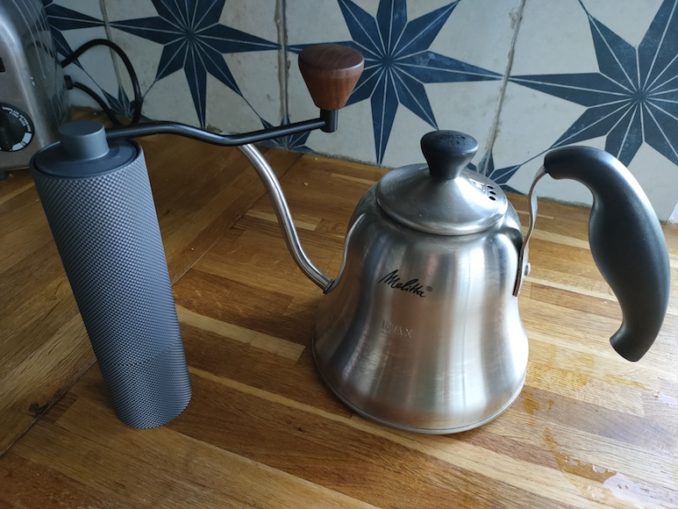
© JimmySP 2022, Going Postal
The theory bit
Coffee brewing processes have two main factors. How water is used to extract the flavour from the ground beans and how you avoid getting the coffee grinds in what you are drinking. The first part has two options: infusion or percolation. Infusion means the coffee sits in the water to infuse. Percolation means the water passes through the coffee. Sounds simple, but coffee lovers have managed to turn this into a complex science.
Turkish Coffee
Turkish coffee requires a small pot called a cezve, a small coffee cup, and you will need a stove. For Turkish coffee you need an extremely fine grind – the consistency of flour. A lot of grinders are not going to be able to produce this so you need to pick the right one, or buy specialist pre-ground coffee. Heat the water up and then stir in the coffee at a ratio of ten to one. When the coffee starts foaming, take it off the heat to prevent it from boiling over. Some techniques call for the coffee to be brought to the foaming stage several times. Let it settle and then pour. Allow the grinds to settle in the bottom of the cup before drinking. This simple infusion technique produces an extremely strong and thick coffee with a unique taste and aroma.
The French Press
The French Press, or cafetiere, gained popularity from the 1950s and is a very simple brewing method. Put your ground coffee in the jug, add boiled water, stir, wait, plunge the plunger, and pour. The beans need to be ground coarsely because the plunger mesh is not very fine. I usually let it infuse (steeping) for up to five minutes before plunging. It produces a rich coffee which retains the oils from the brewing. The other benefit of the French press is you can just as easily make one or six cups depending on your press size. The main downside is cleaning it out afterwards. You also need to keep an eye on the steeping time to ensure consistency. I tend to make a large French press first thing in the morning – so much easier than anything else.
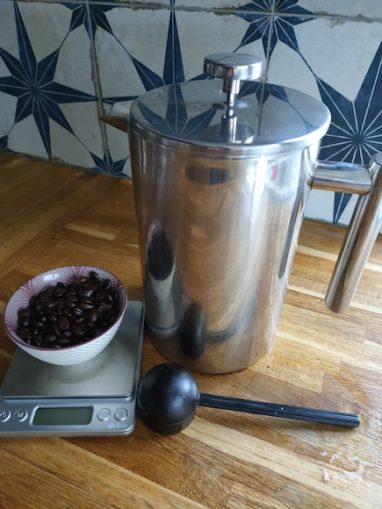
© JimmySP 2022, Going Postal
The Moka Pot
Another technique that uses a stove is the Moka Pot. It was invented in 1933 by Alfonso Bialetti and named after a town in Yemen famed for its coffee. This is a uniquely designed piece of equipment that brews coffee using steam. You grind your beans finely and put them into the middle compartment. The bottom compartment is filled with water that you bring to the boil. The steam percolates through the coffee and condenses in the top compartment. The key is to not overheat but maintain a steady pressure and avoid spluttering. Keep the lid open and as soon as liquid starts oozing out reduce the heat as much as possible. Like the French Press you can get Moka pots in different sizes depending on how many servings you desire. It is a somewhat complicated and time-consuming technique but produces an intense strong coffee. A good alternative if you like espresso.
Pour over
We now introduce filtered coffee. The pour over was invented by a German lady, Auguste Melitta Bentz, in 1908. She hit on the idea of using blotting paper as a filter to remove coffee grinds and the bitter taste of the percolated coffee of the time. Pour over today is a technique particularly loved by coffee geeks because of its ritualistic nature and the control you can get in perfecting a cup. You use a funnel with a filter paper over your cup, put medium or slightly coarser grind coffee in it and slowly pour over boiled water. The water then flows through the grinds and drips through the filter to produce a very smooth and flavoursome drink that lingers in the mouth.
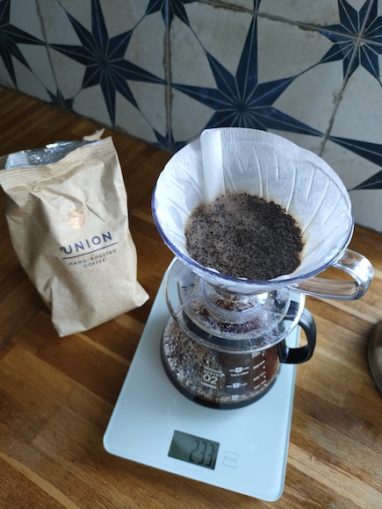
© JimmySP 2022, Going Postal
Pour over is big in Japan and I use the Japanese Hario V60 set of equipment. The basic kit is cheap to buy but does an excellent job. The downside of pour over is that you need to learn good technique to get it consistently right and it takes about three minutes of concentrated work. Many brewers make it on a set of scales with timers to control the pouring. A gooseneck kettle is also preferable for pouring to give you more control – I picked up a small Melitta stove top one that I fill from my electric kettle. It all sounds rather pretentious but pour over coffees do taste amazing. By controlling the variables you can “dial in” very specific taste and strength. I like the 40:60 technique best because it is simple and can produce sweet coffee. If you love coffee but haven’t tried pour over then I would highly recommend it.
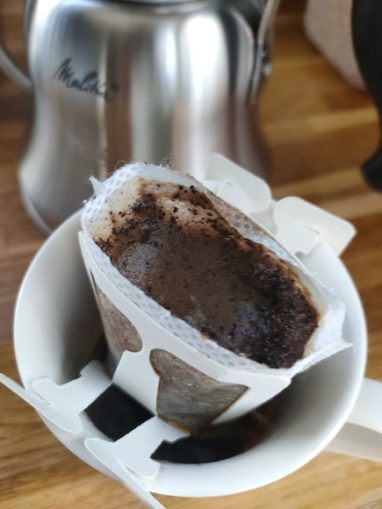
© JimmySP 2022, Going Postal
A less precise version is to use a paper basket filter which sits in your cup using cardboard hanging ears. I first bought these in Japan a few years ago, but they are now available online and are particularly good for travel or the office. If you want to upgrade from instant coffee then this is the simplest way to do that. The taste difference between 12g of real coffee dropped into one of these filters versus putting instant coffee straight into the cup is worlds apart.
The Aeropress
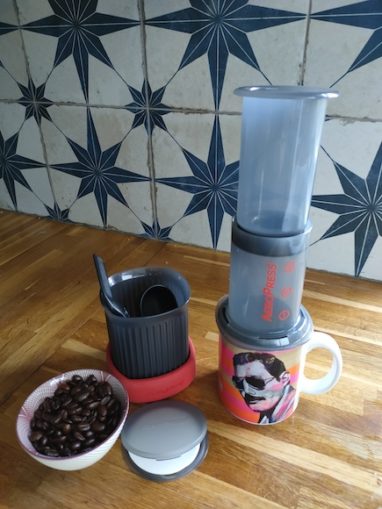
© JimmySP 2022, Going Postal
Finally, we come to a more recent filter invention that has achieved cult status. The mighty Aeropress. It was invented in 2004 by a retired Stanford engineer who wanted more control over his coffee’s taste. The Aeropress has a cylindrical chamber that you attach a small filter paper to. You put your medium-fine coffee and water in and a plunger pushes the water through the bed of coffee and filter using a cushion of air. You get a satisfying hiss once the water has gone through. The device therefore combines the steeping of coffee in water that you get with a French press along with the pressure of passing water through compacted coffee that you get with an espresso machine (although you are only getting about a tenth of the pressure).
There are lots of recipes for how to use an Aeropress to get different results. It was originally designed to produce between 1 and 4 ‘faux-espresso shots’ but brewers now tend to fill it up to produce a tall single cup. Some brewers also invert the Aeropress to let the coffee steep better before plunging. There are regular Aeropress competitions with competitors making tiny adjustments to brew the perfect cup. The Aeropress is fast, great for travel and is also very easy to clean. A final press on the plunger forces the filter and cake of coffee into the bin. If you are making single cups there really isn’t a better fast brewing method in my opinion. The more compact travel version – the Aeropress Go – was released in 2019.
Enjoy your coffee!
© JimmySP 2022



